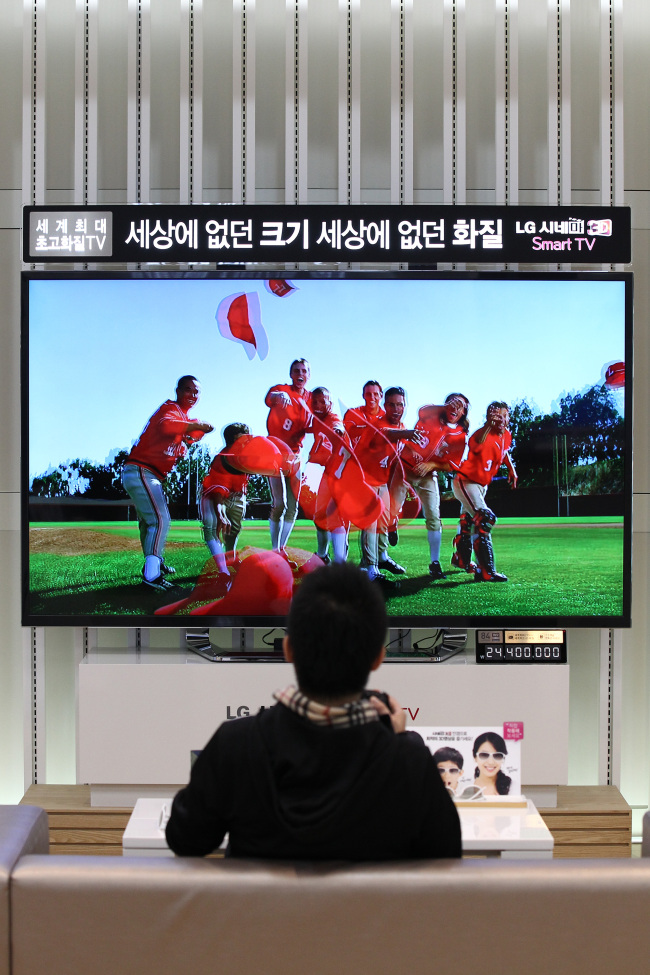LG전자의 무안경 3D TV가 3년 후 양산될 것으로 예상된다.
LG전자의 방영운 상무는 지난 목요일 UHD 컨퍼런스가 끝나고 기자와 만나 “현재 기술 수준을 고려할 때 양산까지 3년 소요될 것” 이라며 “현재 시중에 나와있는 무안경 3D TV는 정면에서만 볼 수 있기 때문에 진정한 3D TV가 아니다” 라고 말했다.

무안경 3D TV의 상용화가 늦어진 점에 대해서 미래부 전파정책기획과는 “관련 코덱, 압축 그리고 플랫폼 네트워크 관련 기술은 ETRI를 통해 거의 완성 되었다. 하지만 디스플레이 등 다른 기술이 좀 더 시간이 소요될 것으로 보인다” 라고 말했다.
한국투자증권의 유종우 연구원도 무안경 3D TV의 양산을 위해서는 “매우 높은 수준의 해상도가 필요하다”라고 전했다.
TV 세트의 기술 개발뿐만 아니라 콘텐츠 제작도 지원이 되야 한다. 방 상무는 “방송에서 제작된 2D 콘텐츠를 3D 프로그램으로 전환하는 기술도 개발 중”이라고 밝혔다.
(코리아헤럴드 신지혜 기자 shinjh@heraldcorp.com)
LG전자의 방영운 상무는 지난 목요일 UHD 컨퍼런스가 끝나고 기자와 만나 “현재 기술 수준을 고려할 때 양산까지 3년 소요될 것” 이라며 “현재 시중에 나와있는 무안경 3D TV는 정면에서만 볼 수 있기 때문에 진정한 3D TV가 아니다” 라고 말했다.

무안경 3D TV의 상용화가 늦어진 점에 대해서 미래부 전파정책기획과는 “관련 코덱, 압축 그리고 플랫폼 네트워크 관련 기술은 ETRI를 통해 거의 완성 되었다. 하지만 디스플레이 등 다른 기술이 좀 더 시간이 소요될 것으로 보인다” 라고 말했다.
한국투자증권의 유종우 연구원도 무안경 3D TV의 양산을 위해서는 “매우 높은 수준의 해상도가 필요하다”라고 전했다.
TV 세트의 기술 개발뿐만 아니라 콘텐츠 제작도 지원이 되야 한다. 방 상무는 “방송에서 제작된 2D 콘텐츠를 3D 프로그램으로 전환하는 기술도 개발 중”이라고 밝혔다.
(코리아헤럴드 신지혜 기자 shinjh@heraldcorp.com)
<관련 영문기사>
LG to commercialize glasses-free 3-D TV by 2017
LG Electronics, the world’s No. 2 TV maker, is expected to mass produce glasses-free 3-D TVs by 2017, much later than the government’s initial commercialization plan.
“It will take at least three years, given the current level of technology,” said Bang Young-woon, the head of LG Electronics’ TV products and planning division after a UHD conference last Thursday.
He added that the glasses-free 3-D TVs out in the market cannot be called fully glasses-free as they offer 3-D vision only when viewed directly from the front.
The government has invested 198 billion won ($183 million) in smart media including smart TVs and glasses-free 3-D TVs since 2011, hoping to see mass production by 2015.
“The government projects to support relevant technologies including codec, compression and platform network are almost done, but improving the display technology seems to be taking longer,” said Shin Jong-sik, a government official at the Ministry of Science, ICT and Future Planning’s radio policy planning division.
Yoo Jong-woo, an analyst at Korea Investment & Securities also said, “Much higher resolution technology is needed to realize glasses-free 3-D TVs.”
In order to see conventional 3-D content with glasses-free TVs, additional shifting technologies are necessary.
The solution for shifting 3-D media content to glasses-free 3-D TVs is equivalent to the price of the TV, meaning prices also need to come down to attract customers, according to Shin.
Also, 3-D content is scarce due to a lack of a value chain to support production.
Bang said LG Electronics is currently developing technology to transition 2-D content into 3-D.
At the international CES 2011 in Las Vegas, LG Electronics, Sony and Toshiba unveiled glasses-free 3D TVs for the first time in a bid to respond to Samsung Electronics’ dominant market share of 3D TVs.
However, interest in 3-D televisions has waned with slow technological development, and in the face of the growing popularity of ultrahigh definition TVs.
By Shin Ji-hye (shinjh@heraldcorp.com)
LG to commercialize glasses-free 3-D TV by 2017
LG Electronics, the world’s No. 2 TV maker, is expected to mass produce glasses-free 3-D TVs by 2017, much later than the government’s initial commercialization plan.
“It will take at least three years, given the current level of technology,” said Bang Young-woon, the head of LG Electronics’ TV products and planning division after a UHD conference last Thursday.
He added that the glasses-free 3-D TVs out in the market cannot be called fully glasses-free as they offer 3-D vision only when viewed directly from the front.
The government has invested 198 billion won ($183 million) in smart media including smart TVs and glasses-free 3-D TVs since 2011, hoping to see mass production by 2015.
“The government projects to support relevant technologies including codec, compression and platform network are almost done, but improving the display technology seems to be taking longer,” said Shin Jong-sik, a government official at the Ministry of Science, ICT and Future Planning’s radio policy planning division.
Yoo Jong-woo, an analyst at Korea Investment & Securities also said, “Much higher resolution technology is needed to realize glasses-free 3-D TVs.”
In order to see conventional 3-D content with glasses-free TVs, additional shifting technologies are necessary.
The solution for shifting 3-D media content to glasses-free 3-D TVs is equivalent to the price of the TV, meaning prices also need to come down to attract customers, according to Shin.
Also, 3-D content is scarce due to a lack of a value chain to support production.
Bang said LG Electronics is currently developing technology to transition 2-D content into 3-D.
At the international CES 2011 in Las Vegas, LG Electronics, Sony and Toshiba unveiled glasses-free 3D TVs for the first time in a bid to respond to Samsung Electronics’ dominant market share of 3D TVs.
However, interest in 3-D televisions has waned with slow technological development, and in the face of the growing popularity of ultrahigh definition TVs.
By Shin Ji-hye (shinjh@heraldcorp.com)


![[Exclusive] Korean military set to ban iPhones over 'security' concerns](http://res.heraldm.com/phpwas/restmb_idxmake.php?idx=644&simg=/content/image/2024/04/23/20240423050599_0.jpg&u=20240423183955)




![[Herald Interview] 'Amid aging population, Korea to invite more young professionals from overseas'](http://res.heraldm.com/phpwas/restmb_idxmake.php?idx=644&simg=/content/image/2024/04/24/20240424050844_0.jpg&u=20240424200058)

![[Pressure points] Leggings in public: Fashion statement or social faux pas?](http://res.heraldm.com/phpwas/restmb_idxmake.php?idx=644&simg=/content/image/2024/04/23/20240423050669_0.jpg&u=)









